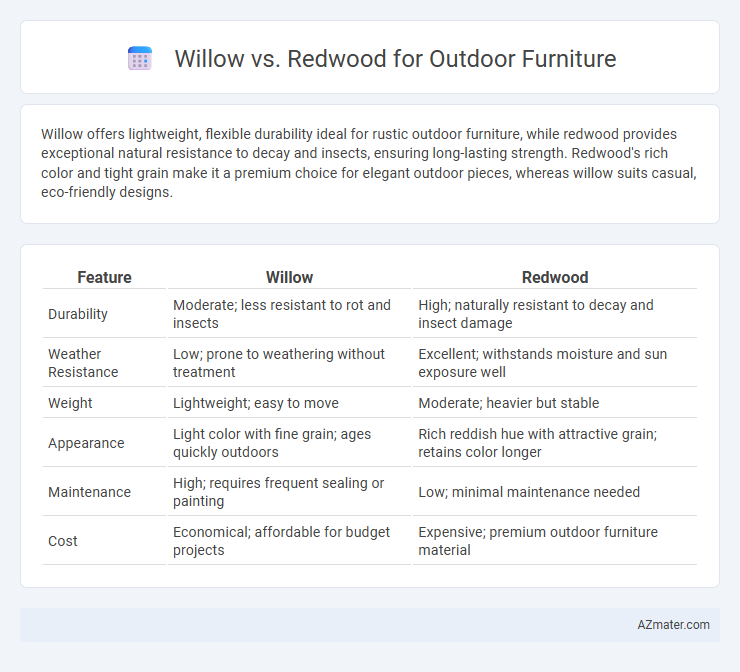Willow offers lightweight, flexible durability ideal for rustic outdoor furniture, while redwood provides exceptional natural resistance to decay and insects, ensuring long-lasting strength. Redwood's rich color and tight grain make it a premium choice for elegant outdoor pieces, whereas willow suits casual, eco-friendly designs.
Table of Comparison
| Feature | Willow | Redwood |
|---|---|---|
| Durability | Moderate; less resistant to rot and insects | High; naturally resistant to decay and insect damage |
| Weather Resistance | Low; prone to weathering without treatment | Excellent; withstands moisture and sun exposure well |
| Weight | Lightweight; easy to move | Moderate; heavier but stable |
| Appearance | Light color with fine grain; ages quickly outdoors | Rich reddish hue with attractive grain; retains color longer |
| Maintenance | High; requires frequent sealing or painting | Low; minimal maintenance needed |
| Cost | Economical; affordable for budget projects | Expensive; premium outdoor furniture material |
Introduction to Willow and Redwood for Outdoor Furniture
Willow and redwood are popular choices for outdoor furniture due to their natural durability and aesthetic appeal. Willow, known for its lightweight and flexible properties, offers a rustic and natural look ideal for casual outdoor settings. Redwood provides exceptional resistance to decay and insects, featuring rich reddish tones that enhance the elegance and longevity of outdoor furniture pieces.
Key Characteristics of Willow Wood
Willow wood is lightweight, flexible, and resistant to moisture, making it an excellent choice for outdoor furniture that needs to withstand varying weather conditions. Its natural elasticity allows it to bend without breaking, providing durability and comfort in garden chairs and benches. Willow typically features a fine, even grain with a pale yellow to light brown color, enhancing outdoor aesthetics while resisting warping and decay.
Key Characteristics of Redwood
Redwood is prized for its natural resistance to decay, insects, and moisture, making it an ideal choice for durable outdoor furniture. Its rich, reddish hue and fine grain texture provide a visually appealing finish that ages gracefully over time. Redwood's stability and strength allow it to withstand various weather conditions without warping or cracking, ensuring long-lasting outdoor use.
Durability and Lifespan: Willow vs Redwood
Redwood offers superior durability for outdoor furniture due to its natural resistance to rot, insects, and moisture, often lasting 20 to 30 years with proper maintenance. Willow, while lightweight and flexible, is less durable outdoors and typically withstands weathering for only 5 to 10 years before showing significant wear. Selecting redwood ensures a longer lifespan and better protection against environmental factors compared to willow.
Weather Resistance Comparison
Redwood offers superior weather resistance for outdoor furniture due to its natural tannins and oils that repel moisture, resist decay, and withstand insects. Willow, while aesthetically pleasing, tends to absorb water more readily, leading to faster wear and potential mold growth in humid or rainy conditions. Choosing redwood ensures longer-lasting durability and low maintenance in harsh outdoor environments.
Aesthetic Appeal and Wood Grain Differences
Willow outdoor furniture showcases a light, almost creamy color with a fine, uniform grain that gives a smooth and elegant look, ideal for modern or minimalist designs. Redwood features a rich, reddish-brown hue with prominent, bold grain patterns that provide a warm, rustic aesthetic suited for traditional or natural outdoor settings. The natural tones of willow create a subtle, airy ambiance, while redwood's deep, striking grains enhance the visual depth and character of outdoor spaces.
Maintenance Requirements
Willow outdoor furniture requires regular upkeep including periodic sealing or oiling to protect against moisture and prevent cracking, especially in humid climates. Redwood furniture is naturally resistant to decay and insect damage, demanding less frequent maintenance aside from occasional cleaning and refinishing every few years to maintain its rich color. Both materials benefit from covering during extreme weather to prolong their lifespan and appearance.
Environmental Impact and Sustainability
Willow outdoor furniture offers a renewable resource with fast-growing properties that absorb significant carbon dioxide, making it an eco-friendly choice compared to slower-growing redwood. Redwood is durable and naturally resistant to pests and decay, reducing the need for chemical treatments, but its longer growth cycle can contribute to deforestation concerns if not sourced sustainably. Opting for FSC-certified willow or redwood ensures responsible forestry practices, promoting sustainability and minimizing environmental impact in outdoor furniture production.
Cost Comparison and Value for Money
Willow outdoor furniture typically costs less upfront than redwood, making it a budget-friendly option for those seeking affordable seating solutions. Redwood, however, offers superior durability and natural resistance to decay and insects, which translates to longer lifespan and lower maintenance expenses over time. Investing in redwood furniture provides better value for money through enhanced longevity and sustained aesthetic appeal despite its higher initial price.
Which Wood Should You Choose for Outdoor Furniture?
Willow and redwood both offer unique benefits for outdoor furniture, but redwood is generally preferred due to its natural resistance to decay, insects, and moisture, ensuring greater durability and longevity. Willow, while lightweight and visually appealing, is less durable and more prone to weathering, making it better suited for indoor or covered outdoor use. Choosing redwood guarantees enhanced sturdiness and minimal maintenance, ideal for furniture exposed to varying outdoor conditions.

Infographic: Willow vs Redwood for Outdoor Furniture
 azmater.com
azmater.com